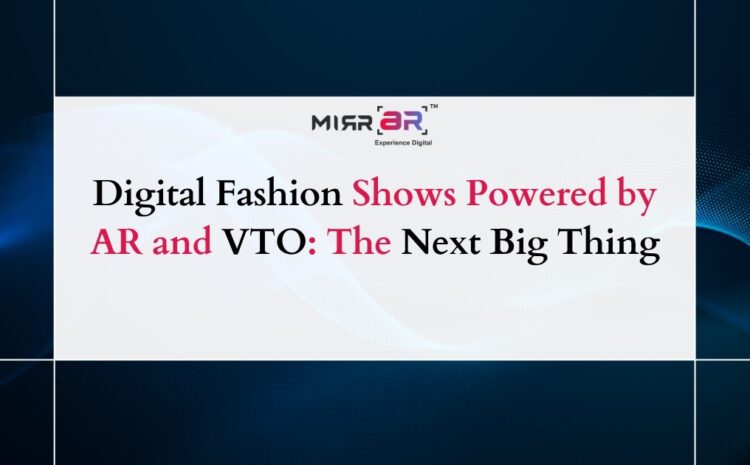The fashion industry has always thrived on innovation — from new textiles and designs to cutting-edge marketing and retail strategies. As we venture deeper into the digital age, augmented reality (AR) and virtual try-on (VTO) technologies are not just enhancing the online shopping experience — they are reshaping the very fabric of fashion presentation. One of the most compelling evolutions is the rise of digital fashion shows powered by AR and VTO, signaling the next big transformation in how designers, brands, and consumers engage with fashion.
The Traditional Runway vs. the Digital Shift
Traditional fashion shows have long been considered the gold standard for unveiling new collections. However, these shows are exclusive, costly, and geographically limited. With the surge in digitalization, especially following the global pandemic, brands were forced to rethink how they showcase their creations. This paved the way for digital fashion shows, where brands could present their collections to a global audience using live-streams and virtual models.
But merely broadcasting fashion shows online was just the beginning. As AR and VTO matured, digital shows evolved into interactive, immersive experiences where audiences don’t just watch — they engage.
What Makes AR & VTO-Powered Fashion Shows Unique?
Imagine a scenario where, instead of watching a model walk down a runway in a designer dress, you could instantly see how that same outfit looks on your own body using virtual try-on technology. Add to that the magic of augmented reality, where the environment around you — be it your living room or a park bench — transforms into a high-end runway, complete with lighting, music, and animated elements.
Here’s how AR and VTO supercharge fashion shows:
- Immersive Presentation: AR environments bring creative storytelling to life, letting designers go beyond physical constraints. A collection inspired by space? Transport viewers to a galactic runway.
- Personalized Interaction: With VTO, viewers can try on pieces in real-time, seeing how garments fit their size, body shape, and style — adding a layer of emotional connection to the fashion show.
- Global Accessibility: No front-row exclusivity. Anyone with a smartphone or AR glasses can have a VIP experience, democratizing access to high fashion.
The Role of Avatars in Digital Fashion Shows
Another groundbreaking trend in this arena is the rise of digital avatars — either brand-created models or personalized avatars of users themselves. These avatars strut the virtual runway, wearing the latest digital collections, with hyper-realistic movements and styling. Consumers can build their own avatars and even attend fashion shows as their virtual selves, making the experience more engaging and social.
This blurs the lines between influencer culture, gaming aesthetics, and fashion presentation — especially resonating with Gen Z and Gen Alpha audiences who are native to such digital environments.
Business Benefits for Brands and Retailers
AR and VTO-powered fashion shows aren’t just artistic statements — they offer tangible business benefits:
- Higher Engagement: Immersive experiences hold audience attention longer and encourage sharing, increasing brand reach.
- Data-Driven Insights: Virtual try-ons allow brands to see which styles are most “tried on” and preferred, guiding production and marketing decisions.
- Reduced Returns: When customers can visualize clothing accurately before purchase, it leads to better decision-making and fewer product returns.
- Sustainable Practices: Digital shows reduce the need for physical samples, travel, and elaborate set production — aligning with sustainability goals.
Notable Examples and Industry Adoption
Luxury brands have already begun exploring this space. For instance, Balenciaga presented a game-like virtual runway for its Fall 2021 collection. Dior, Burberry, and Tommy Hilfiger have all dabbled in AR-based experiences. Meanwhile, platforms like Mirrar are enabling brands to implement VTO in e-commerce and marketing, allowing for real-time customer engagement during fashion showcases.
Moreover, fashion weeks are beginning to adapt. Events like Helsinki Fashion Week and Metaverse Fashion Week are testing grounds for what a fully virtual fashion event can look like — complete with digital garments, avatars, and AR catwalks.
Challenges and the Road Ahead
While the potential is immense, some challenges remain:
- Technology Accessibility: Not all consumers have devices capable of handling high-quality AR or VTO experiences.
- Digital Literacy: Older generations or less tech-savvy audiences may struggle to adapt to these new formats.
- Authenticity vs. Novelty: Brands must ensure that their digital shows feel authentic and on-brand, not just gimmicky tech demos.
Despite these hurdles, the momentum is clear. The integration of AR and VTO into digital fashion shows offers a more inclusive, interactive, and impactful way to experience fashion.
Conclusion
The future of fashion presentation is not just online — it’s interactive, immersive, and deeply personal. Digital fashion shows powered by AR and VTO are rewriting the rules of engagement, bringing high fashion into the hands and homes of everyday consumers. As these technologies evolve, we can expect more lifelike, avatar-driven, and emotionally resonant experiences that make every viewer not just a spectator, but a participant.
